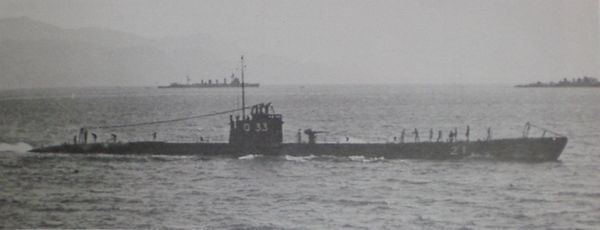Name RO-33 | Commissioned 7 October 1935 | |
 | ||
Displacement 955 tonnes (940 long tons) surfaced1,219 tonnes (1,200 long tons) submerged Length 73 m (239 ft 6 in) overall | ||
The Japanese submarine Ro-33 was a Kaichū type submarine of the K5 sub-class built for the Imperial Japanese Navy (IJN) during the 1930s.
Contents
Design and description
The submarines of the K5 sub-class were versions of the preceding KT sub-class with greater surface speed. They displaced 955 tonnes (940 long tons) surfaced and 1,219 tonnes (1,200 long tons) submerged. The submarines were 73 meters (239 ft 6 in) long, had a beam of 6.7 meters (22 ft 0 in) and a draft of 3.25 meters (10 ft 8 in). They had a diving depth of 75 meters (246 ft).
For surface running, the boats were powered by two 1,450-brake-horsepower (1,081 kW) diesel engines, each driving one propeller shaft. When submerged each propeller was driven by a 600-horsepower (447 kW) electric motor. They could reach 19 knots (35 km/h; 22 mph) on the surface and 8.25 knots (15.28 km/h; 9.49 mph) underwater. On the surface, the K5s had a range of 8,000 nautical miles (15,000 km; 9,200 mi) at 12 knots (22 km/h; 14 mph); submerged, they had a range of 90 nmi (170 km; 100 mi) at 3.5 knots (6.5 km/h; 4.0 mph).
The boats were armed with four internal bow 53.3 cm (21.0 in) torpedo tubes and carried a total of ten torpedoes. They were also armed with a single 76 mm (3 in) anti-aircraft gun and one 13.2 mm (0.5 in) anti-aircraft machinegun.
Construction and career
Commissioned on October 7, 1935 the submarine saw action for Imperial Japanese forces during the Pacific Campaign of World War II. On 7 August 1942, Ro-33 sank the Australian motor vessel Mamutu in the Gulf of Papua near Murray Island, Torres Strait, with the loss of 114 lives. After shelling Mamutu until she was sinking, Ro-33's commander, Shigeshi Kuriyama, then ordered his gunners to open fire on the survivors, men women and children, as they struggled in the water. Of the full complement of passengers and crew, there were only 28 survivors. The submarine was sunk near Port Moresby, Papua New Guinea with all hands (70 officers and men) by the Royal Australian Navy destroyer Arunta at 09°36′S 147°06′E on August 29, 1942.
